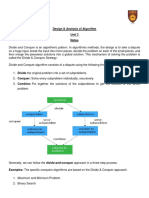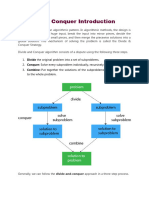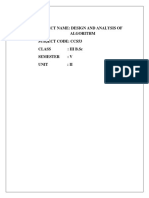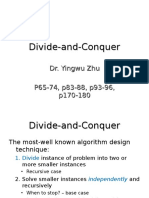0 ratings0% found this document useful (0 votes)
57 viewsDivide and Conquer Introduction
The document discusses the divide and conquer algorithmic pattern. It involves dividing a problem into smaller subproblems, solving those subproblems, and then combining the solutions to solve the original problem. Some examples of algorithms that use this approach include binary search, quicksort, mergesort, and the Tower of Hanoi puzzle. The divide and conquer strategy has two key aspects: a relational formula to break down the problem, and a stopping condition to determine when to stop recursing on subproblems. Applications of divide and conquer include sorting, searching, matrix multiplication, Fourier transforms, and closest pair of points problems. Advantages are that it can solve large problems and uses cache memory efficiently, while disadvantages include high memory usage for recursion.
Uploaded by
Muzamil YousafCopyright
© © All Rights Reserved
Available Formats
Download as DOCX, PDF, TXT or read online on Scribd
0 ratings0% found this document useful (0 votes)
57 viewsDivide and Conquer Introduction
The document discusses the divide and conquer algorithmic pattern. It involves dividing a problem into smaller subproblems, solving those subproblems, and then combining the solutions to solve the original problem. Some examples of algorithms that use this approach include binary search, quicksort, mergesort, and the Tower of Hanoi puzzle. The divide and conquer strategy has two key aspects: a relational formula to break down the problem, and a stopping condition to determine when to stop recursing on subproblems. Applications of divide and conquer include sorting, searching, matrix multiplication, Fourier transforms, and closest pair of points problems. Advantages are that it can solve large problems and uses cache memory efficiently, while disadvantages include high memory usage for recursion.
Uploaded by
Muzamil YousafCopyright
© © All Rights Reserved
Available Formats
Download as DOCX, PDF, TXT or read online on Scribd
You are on page 1/ 5
Divide and Conquer Introduction
Divide and Conquer is an algorithmic pattern. In algorithmic methods, the design is to
take a dispute on a huge input, break the input into minor pieces, decide the problem
on each of the small pieces, and then merge the piecewise solutions into a global
solution. This mechanism of solving the problem is called the Divide & Conquer
Strategy.
Divide and Conquer algorithm consists of a dispute using the following three steps.
1. Divide the original problem into a set of subproblems.
2. Conquer: Solve every subproblem individually, recursively.
3. Combine: Put together the solutions of the subproblems to get the solution to
the whole problem.
Generally, we can follow the divide-and-conquer approach in a three-step process.
Examples: The specific computer algorithms are based on the Divide & Conquer
approach:
OOPs Concepts in Java
1. Maximum and Minimum Problem
2. Binary Search
3. Sorting (merge sort, quick sort)
4. Tower of Hanoi.
Fundamental of Divide & Conquer Strategy:
There are two fundamental of Divide & Conquer Strategy:
1. Relational Formula
2. Stopping Condition
1. Relational Formula: It is the formula that we generate from the given technique.
After generation of Formula we apply D&C Strategy, i.e. we break the problem
recursively & solve the broken subproblems.
2. Stopping Condition: When we break the problem using Divide & Conquer Strategy,
then we need to know that for how much time, we need to apply divide & Conquer. So
the condition where the need to stop our recursion steps of D&C is called as Stopping
Condition.
Applications of Divide and Conquer
Approach:
Following algorithms are based on the concept of the Divide and Conquer Technique:
1. Binary Search: The binary search algorithm is a searching algorithm, which is
also called a half-interval search or logarithmic search. It works by comparing the
target value with the middle element existing in a sorted array. After making the
comparison, if the value differs, then the half that cannot contain the target will
eventually eliminate, followed by continuing the search on the other half. We will
again consider the middle element and compare it with the target value. The
process keeps on repeating until the target value is met. If we found the other
half to be empty after ending the search, then it can be concluded that the target
is not present in the array.
2. Quicksort: It is the most efficient sorting algorithm, which is also known as
partition-exchange sort. It starts by selecting a pivot value from an array followed
by dividing the rest of the array elements into two sub-arrays. The partition is
made by comparing each of the elements with the pivot value. It compares
whether the element holds a greater value or lesser value than the pivot and then
sort the arrays recursively.
3. Merge Sort: It is a sorting algorithm that sorts an array by making comparisons.
It starts by dividing an array into sub-array and then recursively sorts each of
them. After the sorting is done, it merges them back.
4. Closest Pair of Points: It is a problem of computational geometry. This algorithm
emphasizes finding out the closest pair of points in a metric space, given n
points, such that the distance between the pair of points should be minimal.
5. Strassen's Algorithm: It is an algorithm for matrix multiplication, which is named
after Volker Strassen. It has proven to be much faster than the traditional
algorithm when works on large matrices.
6. Cooley-Tukey Fast Fourier Transform (FFT) algorithm: The Fast Fourier
Transform algorithm is named after J. W. Cooley and John Turkey. It follows the
Divide and Conquer Approach and imposes a complexity of O(nlogn).
7. Karatsuba algorithm for fast multiplication: It is one of the fastest
multiplication algorithms of the traditional time, invented by Anatoly Karatsuba in
late 1960 and got published in 1962. It multiplies two n-digit numbers in such a
way by reducing it to at most single-digit.
Advantages of Divide and Conquer
o Divide and Conquer tend to successfully solve one of the biggest problems, such
as the Tower of Hanoi, a mathematical puzzle. It is challenging to solve
complicated problems for which you have no basic idea, but with the help of the
divide and conquer approach, it has lessened the effort as it works on dividing
the main problem into two halves and then solve them recursively. This algorithm
is much faster than other algorithms.
o It efficiently uses cache memory without occupying much space because it solves
simple subproblems within the cache memory instead of accessing the slower
main memory.
o It is more proficient than that of its counterpart Brute Force technique.
o Since these algorithms inhibit parallelism, it does not involve any modification
and is handled by systems incorporating parallel processing.
Disadvantages of Divide and Conquer
o Since most of its algorithms are designed by incorporating recursion, so it
necessitates high memory management.
o An explicit stack may overuse the space.
o It may even crash the system if the recursion is performed rigorously greater than
the stack present in the CPU.
You might also like
- DAA Divide and Conquer Introduction - JavatpointNo ratings yetDAA Divide and Conquer Introduction - Javatpoint14 pages
- Apex Institute of Technology Department of Computer Science & EngineeringNo ratings yetApex Institute of Technology Department of Computer Science & Engineering10 pages
- Algorithm Pattern - DivideAndConquerCMP422No ratings yetAlgorithm Pattern - DivideAndConquerCMP42221 pages
- Unit 2 Divide and Conquer Approach: Structure Page NosNo ratings yetUnit 2 Divide and Conquer Approach: Structure Page Nos40 pages
- Unit 1 Divide-And-Conquer: Structure Page NosNo ratings yetUnit 1 Divide-And-Conquer: Structure Page Nos55 pages
- Module 2A Divide and Conquer Introduction PPTNo ratings yetModule 2A Divide and Conquer Introduction PPT12 pages
- Unit2Part2DivideandConquerApproachpptx 2024 09 11 16 11 57No ratings yetUnit2Part2DivideandConquerApproachpptx 2024 09 11 16 11 5732 pages
- Set Theory Symbols (Sets Symbols and Examples)No ratings yetSet Theory Symbols (Sets Symbols and Examples)13 pages
- Assignment (ANALYSIS AND DESIGN OF ALGORITHMS)100% (1)Assignment (ANALYSIS AND DESIGN OF ALGORITHMS)2 pages
- Worksheet 2 (Revision Tour 1 & 2) Solutions With ExplanationNo ratings yetWorksheet 2 (Revision Tour 1 & 2) Solutions With Explanation19 pages
- To Familiarize and Study The Truth Tables of Various ICs 7400, 7402, 7404, 7408 and 7432, 7436.No ratings yetTo Familiarize and Study The Truth Tables of Various ICs 7400, 7402, 7404, 7408 and 7432, 7436.9 pages
- Backtracking: Satisfies Criterion FunctionNo ratings yetBacktracking: Satisfies Criterion Function39 pages
- Neural Representation of AND, OR, NOT, XOR and XNOR Logic Gates (Perceptron Algorithm)No ratings yetNeural Representation of AND, OR, NOT, XOR and XNOR Logic Gates (Perceptron Algorithm)14 pages
- Applied Numerical Methods: Dr. Khaled Ahmida Al-Ashouri The Libyan Academy - TripoliNo ratings yetApplied Numerical Methods: Dr. Khaled Ahmida Al-Ashouri The Libyan Academy - Tripoli28 pages
- Now It's Time For : Recurrence RelationsNo ratings yetNow It's Time For : Recurrence Relations30 pages
- Book Nelems Bookdetails: Import Public Class Public Private IntNo ratings yetBook Nelems Bookdetails: Import Public Class Public Private Int3 pages
- Apex Institute of Technology Department of Computer Science & EngineeringApex Institute of Technology Department of Computer Science & Engineering
- Unit 2 Divide and Conquer Approach: Structure Page NosUnit 2 Divide and Conquer Approach: Structure Page Nos
- Unit2Part2DivideandConquerApproachpptx 2024 09 11 16 11 57Unit2Part2DivideandConquerApproachpptx 2024 09 11 16 11 57
- Learn Design and Analysis of Algorithms in 24 HoursFrom EverandLearn Design and Analysis of Algorithms in 24 Hours
- Worksheet 2 (Revision Tour 1 & 2) Solutions With ExplanationWorksheet 2 (Revision Tour 1 & 2) Solutions With Explanation
- To Familiarize and Study The Truth Tables of Various ICs 7400, 7402, 7404, 7408 and 7432, 7436.To Familiarize and Study The Truth Tables of Various ICs 7400, 7402, 7404, 7408 and 7432, 7436.
- Neural Representation of AND, OR, NOT, XOR and XNOR Logic Gates (Perceptron Algorithm)Neural Representation of AND, OR, NOT, XOR and XNOR Logic Gates (Perceptron Algorithm)
- Applied Numerical Methods: Dr. Khaled Ahmida Al-Ashouri The Libyan Academy - TripoliApplied Numerical Methods: Dr. Khaled Ahmida Al-Ashouri The Libyan Academy - Tripoli
- Book Nelems Bookdetails: Import Public Class Public Private IntBook Nelems Bookdetails: Import Public Class Public Private Int






































































































